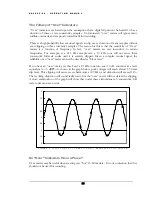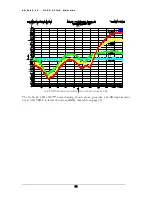
A D 2 4 0 2 - 9 6 - O P E R A T I N G M A N U A L
eye is much too slow to allow us to see an LED light up for one sample of a 44.1 kHz or 48 kHz
clock. Therefore, the meters on the AD2402-96 incorporate a decay time constant which extends
the on-time of all LEDs, and a second slower time constant which extends the on time of the
highest LED triggered by a peak. Even the shortest transient can be observed.
Fast Decay Time-Constant
The fast time-constant is active in all meter modes. Its purpose is to compensate for the relatively
slow response of the human eye. Here is how it works: If any segment of the LED meter turns
on, it and all of the segments below it, are held on for 375 samples (or 7.8 msec). This 7.8 msec
“on-time” is just long enough to make the LED clearly visible to the human eye. At the end of
the 7.8-msec delay, the first time constant releases its control of the meter segments. If a higher
peak should occur during the 7.8 msec interval, this new peak will be displayed, and the 7.8 msec
timer will restart. Thus no peaks are ever missed, and all are visible.
Slow Decay Time-Constant
The slow time-constant is active whenever the peak hold function is off. After the first time
constant releases control of the meter segments, a second 0.5-sec time constant will continue to
keep the highest illuminated LED lit. All meter segments below this LED will continue to display
peaks using the 7.8 msec time constant. At the end of 0.5 sec, the highest illuminated LED will
shut off, and the LED below it will turn on. This will restart the 0.5-sec timer. Thus, peaks will
decay at a rate of one-meter segment every 0.5 seconds. However, if at any time, an audio peak
occurs which is higher than the one being held the new peak will be held and the timer will
restart. Again, no peaks are lost, and all are visible.
23
















































